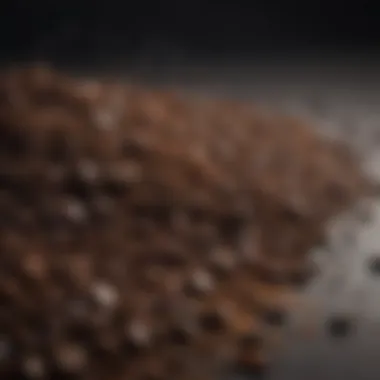Exploring Coffee Grounds: Economic and Culinary Insights


Intro
Coffee is not just a morning ritual; it's a versatile ingredient that can transform dishes in unexpected ways. One often overlooked aspect is coffee grounds. These little remnants from your brewing process can actually offer a treasure trove of economic and culinary benefits. This section highlights how coffee grounds fit into the modern culinary landscape and why they merit serious consideration.
When you think about it, coffee grounds are more than just waste. They have the potential to enhance flavors, add texture, and even serve as a means of waste management. All these factors lead to a deeper insight into their cost implications. As culinary enthusiasts become more aware of sustainability, it’s crucial to identify where coffee grounds fit into the cost-benefit analysis in the kitchen.
The value of coffee grounds isn’t just monetary; it extends into enhanced culinary experiences, waste reduction, and an eco-conscious approach to cooking. As we take a closer look, remember that every cup of coffee can potentially lead to creative culinary masterpieces or innovative waste solutions.
Recipe Overview
Brief Description of the Dish
Imagine making a chocolate cake that surprises your guests. By incorporating coffee grounds, the dessert transforms into a rich, flavorful experience that elevates it beyond the ordinary. The earthy notes from the coffee mingle beautifully with the sweetness of chocolate, adding depth and complexity. Plus, using coffee grounds helps reduce waste while offering a unique twist to a beloved dessert.
Key Ingredients
- All-purpose flour
- Granulated sugar
- Unsweetened cocoa powder
- Baking powder
- Eggs
- Milk
- Vegetable oil
- Used coffee grounds (make sure they are dry)
Now that we've set up the scene, let’s get into how to prepare this remarkable cake. Each step presents unique opportunities to explore the cost implications of using coffee grounds in culinary applications.
Prelude to Coffee Grounds Cost
Understanding the costs associated with coffee grounds is essential in today’s culinary landscape. As chefs and home cooks alike explore innovative ways to use ingredients, coffee grounds have emerged as a versatile component that offers more than just flavor. They can be flavorful additions to recipes and also serve unique purposes, from enhancing the taste of dishes to acting as a natural tenderizer. The financial benefits of incorporating coffee grounds go beyond mere budgeting; they foster creativity in kitchens everywhere.
When we talk about coffee as a commodity, several layers must be opened up. From the cultivation of coffee beans to the moment they become grounds, there’s an entire economy at play. Knowing these costs can drastically effect decision-making processes in both commercial and personal kitchens.
Understanding Coffee as a Commodity
Coffee has been a staple commodity for centuries, with a history deeply entwined in global trade. This beloved beverage does not just provide warmth and energy; it creates a vast market where pricing fluctuates based on quality, region, and season. Coffee grows best in specific climates where agricultural circumstances can lead to a richer, fuller taste.
- Market Dynamics
The price of coffee is sensitive to various factors such as weather conditions, harvesting seasons, and political stability in producing countries. Brazil, Vietnam, and Colombia dominate the coffee landscape, contributing significantly to supply. Even geopolitical issues can cause prices to swing, as seen when unrest strikes coffee-growing regions. - Cost of Production
From planting to roasting, the cost of producing high-quality coffee is substantial. Most commercially produced coffee goes through a series of processing steps, such as washing and drying, which add to overall expenses.
Examining these elements helps to recognize how each step can potentially increase costs at the consumer level. If coffee ends up costing more, what are the implications for the grounds left behind? Significant shifts in the global market not only affect the price of brewed coffee but also raise questions about what happens when the drink’s essence is extracted. Can these grounds be seen as valuable rather than waste?
The Transformation Process from Coffee Bean to Grounds
The journey of coffee from bean to ground involves various steps that either add or minimize costs. Initially, freshly harvested coffee beans are lush with flavor, but processing them efficiently brings its own challenges.
- Harvesting
Once the coffee cherries are picked, they are either processed dry or wet. Each method has its quirks, often leading to different flavor profiles and, consequently, different price points in later sales. - Processing
Beans undergo a significant transformation through washing, fermenting, and drying. Each step sees labor costs, processing equipment, and energy consumptions playing a crucial role in determining final expenses. - Roasting to Grounds
Roasting not only affects taste but is also a delicate operation requiring precise timing, temperature control, alongside good equipment. After the beans are roasted, they are ground to different sizes depending on intended use, whether for espresso, drip coffee, or even culinary recipes.


The transformation of beans into grounds reveals a significant production timeline that greatly influences pricing. Understanding these steps can help culinary enthusiasts appreciate the value of using coffee grounds in recipes, turning what might be considered waste into treasures that enhance flavor and support sustainable practices.
Analyzing Financial Aspects of Coffee Grounds
Understanding the financial aspects of coffee grounds is essential for anyone involved in culinary arts, especially those looking to innovate in the kitchen while keeping an eye on costs. The consideration goes beyond merely assessing the basic prices of coffee grounds. It opens up a broader discussion about the economic landscape associated with coffee production and its diverse applications in cooking and baking. By analyzing these financial implications, culinary enthusiasts can better appreciate both the value and the waste that coffee grounds represent.
In this section, we will explore the direct costs incurred during coffee production, the variations in costs tied to different coffee types, and the influence of market trends on pricing. Each of these elements contributes to a holistic understanding of how coffee grounds can be economically viable ingredients and the costs that may arise from their utilization in various recipes.
Direct Costs of Coffee Production
The journey of coffee from bean to ground involves several financial layers. First and foremost, there are the direct costs associated with coffee farming and processing. These can include:
- Labor: The workforce required for planting, harvesting, and processing coffee can significantly affect overall costs. In regions where coffee is grown, labor may make up a large chunk of total expenses.
- Materials: This encompasses fertilizers, pesticides, and equipment needed for cultivation. Depending on the farming methods (organic vs. conventional), this can vary greatly.
- Transport: After harvesting, coffee beans need to be transported to processing facilities, which adds another layer of costs.
These direct costs can influence the final price of coffee grounds for consumers. With fluctuations in global supply chains and climatic conditions impacting crop yields, understanding these elements can help chefs and home cooks alike in budgeting and planning their culinary adventures using coffee grounds.
Cost Variations in Different Types of Coffee
Not all coffee is created equal. Variations in coffee types lead to differing costs for grounds, heavily influenced by:
- Quality: Specialty coffees often come with a higher price tag due to their unique flavors and meticulous farming practices. This means their associated grounds can also command a premium price.
- Origin: Coffees sourced from renowned locations like Colombia or Ethiopia generally have distinct price points compared to more common varieties. Factors such as terroir and processing methods play a role in this distinction.
- Processing Style: Whether the coffee is wet-processed or dry-processed can affect costs considerably. Unique processing methods may yield intriguing flavors, but they often come with higher production costs, reflected in the ground prices.
By recognizing these variations, culinary experts can make informed decisions aligning their recipe choices with their budget constraints. The right understanding of costs can elevate dishes without inflating expenses unduly.
Market Trends and Their Impact on Costs
Coffee is not just a beverage; it’s a trend-affected commodity. Current market forces shape how much consumers really pay for coffee grounds. Key elements to contemplate include:
- Supply and Demand: Whether it’s a bumper crop or a production shortfall, the principles of supply and demand can dramatically impact prices. A shortage in coffee production may spike end prices, affecting costs for ground products.
- Sustainability Trends: With growing consumer awareness of sustainability, price points can shift. Organic, fair-trade, or sustainably-sourced coffee products often come with a premium, thus affecting the overall cost of the grounds.
- Technological Innovations: Advancements in processing technology may lead to lowered production costs, which, in turn, can influence the pricing of grounds. This is particularly true when sustainable practices are implemented at scale.
Utilization of Coffee Grounds in Culinary Settings
Utilizing coffee grounds in culinary settings is not just a trend but a profound shift in how we perceive waste in the kitchen. This section sheds light on why coffee grounds are worthy of attention as a valuable ingredient rather than mere leftovers. Harnessing the power of used coffee can add flavor, texture, and nutritional benefits to a variety of dishes while also addressing waste management. The importance of this topic lies in promoting a zero-waste philosophy, encouraging home cooks and professional chefs alike to think creatively when reaching for their ingredients.
Culinary Applications of Coffee Grounds
From rubs for meat to ingredients in desserts, the culinary applications of coffee grounds are vast. Many might not realize how versatile this humble byproduct can be. Here’s a look at some innovative ways to incorporate coffee grounds into recipes:
- Seasonings: Coffee grounds can create unique spice blends. Mixing them with spices like paprika or salt can bring new dimension to meats, especially beef and pork.
- Baking: Ground coffee adds depth to baked goods, enhancing cookies, brownies, and cakes with a rich mocha flavor.
- Savory Dishes: Infusing coffee into broths or marinades can impart a smoky, rich taste that makes dishes stand out.
Utilizing coffee grounds in these ways elevates simple recipes into something quite extraordinary.


Nutritional Benefits of Coffee Grounds as Ingredients
The nutritional benefits of coffee grounds shouldn't be overlooked. While many people throw out their coffee grounds without a second thought, they contain essential nutrients that can enhance health. Consider the following:
- Antioxidants: Coffee grounds are rich in antioxidants, which can help combat free radicals in the body.
- Fiber: The grounds provide a decent amount of dietary fiber, aiding digestion when incorporated into foods.
- Minerals: They're packed with minerals like magnesium and potassium, which are vital for various bodily functions.
"Using coffee grounds not only reduces waste but also introduces beneficial nutrients into our diets."
Cost-Effectiveness of Coffee Grounds in Recipes
From an economic standpoint, the cost-effectiveness of coffee grounds is undeniable. Here are a few reasons why incorporating them into recipes makes good financial sense:
- Waste reduction: By using something that would typically be discarded, you effectively decrease kitchen waste, potentially lowering disposal costs.
- Flavor boost: Adding coffee grounds to dishes can enhance flavor without the need for more expensive spices or ingredients, allowing you to maximize flavor while minimizing costs.
- Creativity: Experimenting with coffee grounds can lead to unique recipes that stand out in the culinary world, which could set home cooks or restaurants apart and even attract more customers.
Used wisely, coffee grounds present an economical and sustainable option that can intrigue food lovers while promoting innovative cooking. By shifting perceptions of coffee grounds from waste to ingredient, the culinary possibilities become endless.
Waste Management and Sustainability Perspectives
Addressing the topic of waste management and sustainability is crucial when considering the economic implications of coffee grounds in culinary applications. With an increasing focus on environmentally friendly practices, understanding how to use coffee grounds effectively can provide significant advantages for both the kitchen and the planet. The transformable nature of coffee grounds means that these by-products can be woven into sustainable practices, offering benefits that extend from personal use to broader ecological impacts.
Coffee Grounds in Composting and Gardening
Coffee grounds are often hailed as a gardener's best friend. Their rich nitrogen content makes them a stellar addition to compost piles, fostering a lively environment for decomposing organic matter. Not only that, but when worked into the soil, these grounds enhance drainage, aeration, and even help retain moisture. This can ultimately lead to more fruitful gardens.
Here are some specific benefits:
- Nutrient Density: The grounds contain essential nutrients like potassium, phosphorus, and magnesium.
- Soil Structure Improvement: They can lighten compacted soil, ensuring better root growth.
- Pest Deterrent: Some gardeners believe the texture of coffee grounds can deter pests like slugs and snails.
These attributes underline the significance of reuse, and they don’t just improve gardens; they also divert waste from landfills, making coffee grounds a win-win solution for eco-conscious consumers.
Environmental Impact Reduction through Reuse
When discussing the environmental effects of coffee consumption, the focus often turns to waste. Millions of coffee grounds end up in landfills each day, where they decompose anaerobically, producing methane – a potent greenhouse gas. By reusing coffee grounds, we can alleviate some of this burden.
Consider these aspects of reuse:
- Carbon Footprint Reduction: Using coffee grounds for purposes like exfoliants in skin care or natural dyes can minimize the overall carbon footprint.
- Waste Diversion: Giving a second life to coffee grounds keeps them out of rubbish heaps, contributing to lower overall waste production.
- Natural Resource Conservation: When grounds are repurposed, there’s less dependency on manufactured products, leading to a reduction in resource consumption and pollution tied to their production.
"Every coffee cup holds the potential for something greater; recycling coffee grounds is a step towards embracing a zero-waste lifestyle."


Economic Benefits of Sustainable Practices
The economic implications of embracing sustainability with coffee grounds extend beyond environmental considerations. When consumers incorporate coffee grounds into their culinary practices or gardening efforts, they inadvertently save money.
Here’s how:
- Cost-Effective Ingredient: Using leftover coffee grounds in recipes not only enhances flavor but also reduces the need to buy additional ingredients.
- Enhanced Productivity: In gardening, the use of coffee grounds can lead to bountiful harvests, translating to financial savings compared to purchasing fertilizers.
- Community Sustainability Initiatives: Local businesses utilizing coffee grounds for compost can foster community initiatives, encouraging local economies and interactions among consumers.
Keeping these points in mind, the implications of coffee grounds reach far and wide. A practice as simple as reusing coffee grounds can lead to profound changes, making culinary applications not just economically savvy but also environmentally responsible.
Consumer Behavior and Coffee Grounds Cost Perception
Understanding consumer behavior regarding coffee grounds is essential in illustrating how these leftover materials are viewed economically and how they fit into the culinary landscape. The perception of coffee grounds often swings from an underrated resource to an overlooked waste item. In this section, we delve into the attitudes that fuel these perceptions and assess their impact on both culinary uses and sustainability.
Market Perception of Coffee Grounds as Waste
The dominant view for many is that coffee grounds are merely waste. A significant portion of the populace tosses used grounds into the rubbish bin without a second thought. This perspective diminishes the potential of what could be a valuable resource in the kitchen.
- Economic Implications: When consumers see coffee grounds as trash, they miss out on potential savings. The notion that coffee grounds are disposable leads to a reluctance to experiment with them as cooking or baking ingredients. This can stifle innovation and limit cost-effective culinary uses.
- Sustainability Concerns: Throwing coffee grounds away contributes to landfill. In the grand scheme, this not only increases waste but also runs counter to growing trends focused on sustainability. Recognizing their value could encourage more environmentally conscious practices.
"Seeing coffee grounds as nothing more than waste is like tossing away gold without knowing its worth."
Changing Attitudes Towards Reused Coffee Grounds
A slow shift is happening in attitudes towards reused coffee grounds, encouraged by awareness around sustainability and culinary creativity.
- Culinary Experimentation: As food enthusiasts dive deeper into the realms of gastronomy, many have found innovative ways to incorporate coffee grounds into their dishes. From infusing flavors in desserts to enhancing savory sauces, the versatility is surprising. Increasingly, recipes feature coffee grounds as a highlight rather than a leftover.
- Community Advocacy: Online platforms, including social media and forums like reddit.com, share recipes and tips for reusing coffee grounds. This grassroots level of advocacy is helping reshape perceptions. Consumers are starting to recognize what once seemed like waste can, in fact, elevate their culinary creations and reduce overall costs in the process.
- Ingredient Awareness: The rise of discussions around health benefits has also shifted perspectives. Coffee grounds are rich in nutrients and antioxidants. As consumers become educated about these benefits, the idea of using grounds in recipes becomes more appealing.
The evolution in how coffee grounds are perceived—from being considered waste to being seen as a culinary asset—reflects broader trends in consumer behavior. Awareness, creativity, and economic rationale all contribute to the growing acceptance of coffee grounds, helping to drive a more sustainable and engaging culinary culture.
Epilogue: The Future of Coffee Grounds in Culinary Use
Potential Innovations in Culinary Applications
In recent years, the culinary industry has experienced a surge in creativity, pushing boundaries and exploring new frontiers. Coffee grounds are at the center of this trend, showing that innovation remains a key player in how we perceive traditional ingredients.
- Flavor Enhancer: Chefs are experimenting with coffee grounds to infuse dishes with rich, earthy tones. From rubs for meats to unexpected additions in desserts, the depth they provide is remarkable. Imagine a dark chocolate cake subtly enhanced by the hint of coffee's bitterness, elevating the experience.
- Gluten-Free Alternatives: Ground coffee has found a place in gluten-free recipes, acting as a binding agent or even replacing flour in certain formulations. This is particularly advantageous in artisan baking, where unique textures are sought.
- Beverage Innovations: And it's not just solids; coffee grounds are being used to create innovative drinks. Think of coffee-infused cocktails or even craft beers that utilize coffee grounds in the brewing process, adding another layer of flavor that resonates with coffee lovers and enthusiasts.
These possibilities not only broaden the culinary horizons but also encourage industries to develop new markets for coffee grounds, contributing to their economic viability.
Sustainable Trends and Consumer Engagement
Sustainability isn’t just a buzzword anymore; it’s become a fundamental value in the culinary world. Coffee grounds embody this trend by promoting responsible consumption and waste reduction.
- Awareness of Waste: As consumers become more educated about the food supply chain, awareness of food waste grows. Coffee grounds, seen as an inevitable by-product of brewing, are being embraced as an ingredient rather than discarded as refuse. This cultural shift is vital for encouraging sustainable practices within kitchens.
- Upcycling Initiatives: Many restaurants and businesses are now focusing on upcycling coffee grounds into viable products for the consumer market. Products like artisanal soaps, body scrubs, and even biodegradable packaging made from coffee grounds are gaining traction.
- Consumer Engagement Strategies: Chefs and food entrepreneurs are finding ways to actively involve customers in sustainability initiatives. Workshops on reusing coffee grounds, whether in cooking or for gardening, help educate the generationally curious and environmentally-conscious audience we see today.
"As the culinary landscape evolves, coffee grounds stand as a testament to the innovative spirit that drives not only flavor enhancement but also sustainability in gastronomy."







